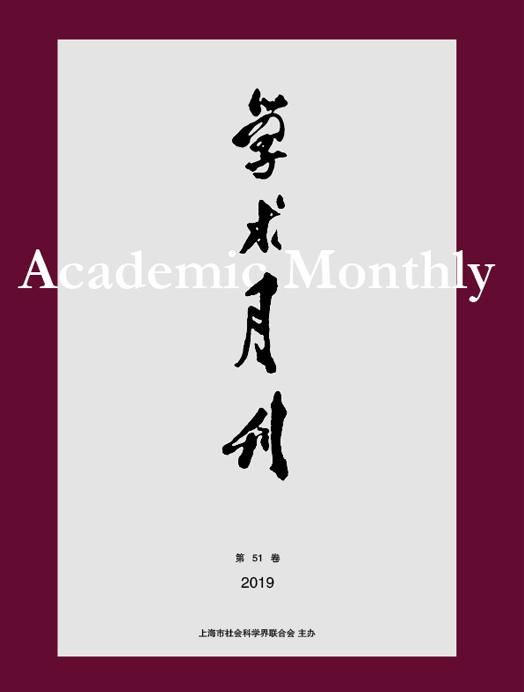Citation:
Qintong LI. The Confucianization of Law and Its Explanation[J]. Academic Monthly, 2020, 52(8): 157-169.

The Confucianization of Law and Its Explanation
-
Abstract
In the backgrounds of the knowledge of legal history in modern times, Qu Tongzu used the Confucianization of law to describe the development of Chinese penal statutes. It explains the phenomenon of introducing rites into laws which started from the Han Dynasty and thrived in Wei and Jin. The basis of the theory is that rites separated from laws in the Spring and Autumn and the Warring States periods, after morality, rites, politics and penalties separated from Zhou Rites, the rites could be integrated into laws. The Confucianization of law can correctly explain the development of penal laws after the midterm of the Western Han Dynasty. However, as the theory of Confucianization of law includes conflicts with the power of the Emperor, it can only explain the development of the penal laws to an extend. In the view of penal laws and its practice, the confucianization of the judicial practice developed not so deep as that of penal laws, since the judicial system returned to utilize the practice of legalism after it had experienced the process of confucianization of law. Besides, even in the penal laws there existed the theory of legalism, which can be explained by the process of the integration of Confucianism and Legalism or the integration of rites and laws.
-

-
References
-
Access
-
-
[1]
Jin DING
. New Interpretation of the Law of Government Subordination in Zhou Li. Academic Monthly,
2022, 54(12): 165-175.
-
[2]
YANG Guorong
. Rituals as the Normative System—— Modern Significance of Classic Studies in The Rituals,Rituals of Zhou Dynasty,and The Book of Rituals. Academic Monthly,
2024, 56(2): 33-44.
-
[3]
Dongping ZHOU
, Yifeng XUE
. On a New Theory of the History Regarding the Formation of the Medieval Penalty System of “Five Punishments” against the Backdrop of the Hu-Han Fusion in Northern Dynasty. Academic Monthly,
2021, 53(3): 181-192.
-
[4]
Guo Yongjian
. . Academic Monthly,
2018, 50(5): 128-137.
-
[5]
Jinhua CHENG
. Normalization of Facts in the Legal System. Academic Monthly,
2021, 53(3): 114-124.
-
[6]
Jing XIE
. Grounds of Criminal Penalty between Confucianism and Legalism: The Ancient, Modern, Chinese and Western Dimensions of Penalty for Theft in the Qing Code. Academic Monthly,
2019, 51(8): 106-121.
-
[7]
Xiangping LI
, Minghui YAO
. The Deification by the Sacred King: The Order and Mentality of the Beliefs of Hierarchy Determined by Virtues. Academic Monthly,
2021, 53(6): 99-107.
-
[8]
. . Academic Monthly,
2016, 48(07): 66-78.
-
[9]
Shaohua ZHENG
, Hui WANG
. Environmental Code: Its Positioning and Codification. Academic Monthly,
2020, 52(8): 129-141.
-
[10]
Ping FU
. Creating Leading-edge Integrated Governance: The Governance Innovation of Poverty Alleviation in China. Academic Monthly,
2021, 53(7): 121-131.
-
[11]
. The Internal Logic of “Sharing Economy” and Public Policy. Academic Monthly,
2018, 50(04): 86-97.
-
[12]
He Yuchang
, Fang Kun
. . Academic Monthly,
2018, 50(5): 56-67.
-
[13]
Hailiang MENG
. The Integration of Multiple Disciplines Promotes the Ancient Ethnic Genealogy Research. Academic Monthly,
2022, 54(10): 200-216.
-
[14]
Zhang Shufang
. . Academic Monthly,
2018, 50(5): 88-100.
-
[15]
Bohai CHEN
. An Interpretation of Confucian View of “Sentiment and Disposition”. Academic Monthly,
2021, 53(9): 151-158.
-
[16]
Yanping GAO
. Herder on Touching: Aesthetics of “Dunkelheit” (Darkness). Academic Monthly,
2018, 50(10): 130-139.
-
[17]
Xudong ZHAO
. Custom As Law and Legal Studies of Customs. Academic Monthly,
2019, 51(6): 94-103.
-
[18]
Feng LUO
. On the Origin of the CPC’s Thoughts of Governance of China. Academic Monthly,
2021, 53(6): 108-120.
-
[19]
. . Academic Monthly,
2016, 48(07): 99-108.
-
[20]
ZHAI Yi
. A New Discussion on the Justification Review Method of the Principle of Proportionality—— A Perspective that Integrates Law,Economics,and Negotiation Theory. Academic Monthly,
2024, 56(3): 107-119.
-
-



 沪公网安备 31010102003103号
沪公网安备 31010102003103号 DownLoad:
DownLoad: